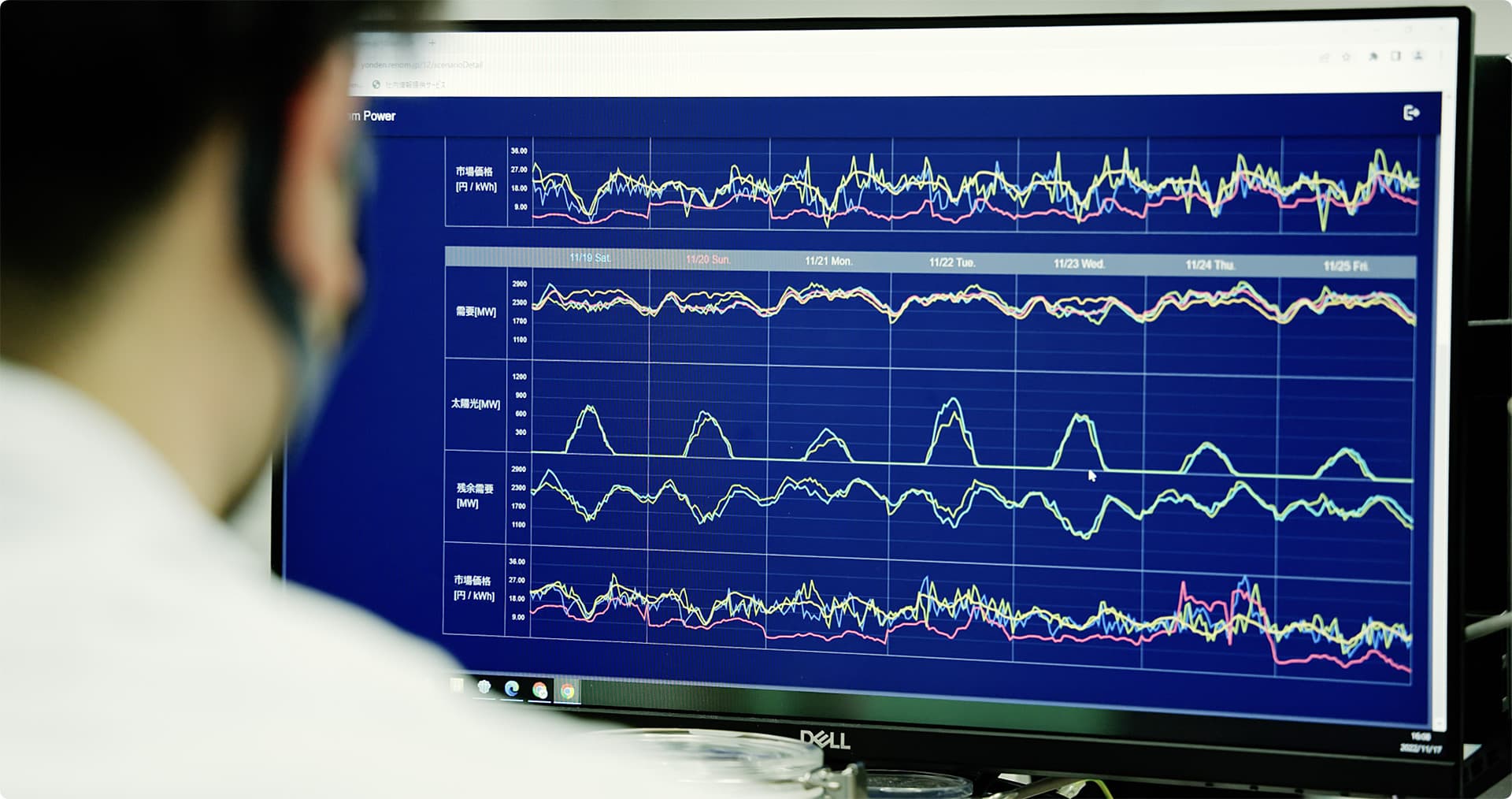Special Interview
Sikoku Electric Power Co.
Development of AI to optimize and automate electricity supply and demand planning
Use Case
2023.03.12
Shikoku Electric Power operates using the electricity supply-demand planning system developed by the Grid. The highly accurate electricity supply-demand planning optimization system was realized by utilizing the Grid's AI optimization technology and digital twin technology that reproduces real space on a virtual space. We asked a Shikoku Electric Power representative about the background to the introduction of the system, the effects of using the grid's system, and their future aims.

Mr. Junya Konishi
General Planning Office, Supply and Demand Management Department, Supply and Demand Management Group

Mr. Norito Furubayashi
General Planning Office Supply and Demand Management Department
Duties
We are engaged in the overall electric power business mainly in the Shikoku region. The Supply and Demand Operation Department, of which we are a part, is responsible for forecasting customers' electricity consumption and renewable energy generation, planning the operation of thermal and hydroelectric power plants, and trading electricity in the market.

Background
To develop power business plans, we create scenarios using these three parameters: electricity demand, renewable energy generation, and market prices, and use these scenarios to develop generation plans for thermal and hydroelectric facilities. However, since scenarios are highly variable and scenarios do not always come true, it is necessary to create scenarios with a certain amount of upside and downside potential. This would result in a very large number of combinations, as well as a large number of generation plans to be developed for each scenario. This makes it very difficult to properly evaluate the cost of operating each power generation plan, and before the introduction of the grid system, it took a considerable amount of human time just to create one scenario pattern. As a result, there were limitations in creating multiple scenarios with various combinations and analyzing them to develop the most economical supply-demand plan. To address these issues and optimize and accelerate supply-demand planning, we began research and development with Grid, which has AI knowledge, in December 2020, and began system operation in July 2022.
What will be the deciding factor in your decision to hire Grid?
Knowledge and experience in AI was essential for the development of this system, but we had absolutely no experience in AI implementation. Among various AI companies, we decided to request Grid because of its expertise in AI specialized in optimization calculations and its experience in developing and implementing AI systems for infrastructure companies.

Please let us know what you appreciate about the grid.
Grid studied not only the software development but also the business of electricity supply-demand planning, and in the development process, I believe that Grid was able to grasp the needs of the field and develop the system to meet those itches. Even after the system was put into operation, the company responded promptly to suggestions for improvement based on actual use, and I believe that the system has evolved into a better system.

Please tell us about the system you have installed.
The system (ReNom Power) introduced this time is an electricity supply and demand planning system using AI optimization technology. The system consists of three major functions. The first is a scenario creation function, the second is a power generation planning function, and the last is an expected revenue calculation function. The first function, scenario creation, creates scenarios using as input data the power demand, weather information, and electricity market prices assumed in the weekly plan. Specifically, ReNom Power creates 100 scenarios, from which 10 scenarios are carefully selected and presented. Ultimately, we in the business unit narrow down those 10 scenarios to 2 or 3 scenarios for use. The second function, power generation planning, develops a power generation plan based on the scenarios created by the scenario creation function, taking into account constraints such as equipment specifications of generators and outage information of equipment stoppages. The third function, expected revenue calculation, first calculates the expected revenue when electricity demand, market prices, and renewable energy generation fluctuate for the optimal generation plan corresponding to each scenario, then analyzes and evaluates the expected revenue, including the range of fluctuation, and presents it to the operator. ReNom Power is currently contributing to the optimization of planning as an indicator for operators to select the optimal plan.
What are the effects after the introduction of the system?
In terms of operations after the introduction of the system, we have seen two positive effects: first, we are now able to evaluate economic efficiency, and second, we have visibly improved the efficiency of our operations. First, economic evaluation was only possible with the conventional operation, which was based on a two-point daily balance, i.e., whether the supply capacity was sufficient for the demand. However, by using Renom Power, we are now able to evaluate not in terms of a 48-point balance, but in terms of a line. The second point is the improvement of operational efficiency. With Renom Power, multiple scenarios can be considered by first inputting the data.

What are your plans for future use?
Recently, the supply-demand situation has been fluctuating greatly due to the tight supply and demand of electric power and soaring fuel prices. We are now in a world where the results of last year and the year before are no longer valid. In this environment, new market systems are being introduced, and we would like to update our system to take these circumstances into account. We would also like to proceed in such a way that the weekly plan can be reflected in the next day's plan, which is closer to the actual demanded salary.